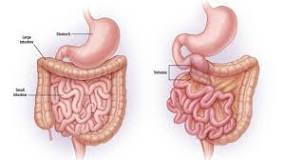Situs Inversus.
P.K.Ghatak, M.D.
Situs Inversus is an abnormal position of internal organs. When all the thoracic and abdominal organs are on the reversed side of the body, the condition is called Situs Inversus Totalis. Situs Inversus Totalis is rare, happening in 1 out of 10, 000 births, but it does not interfere with a normal life. This condition may be missed by a doctor when pretending examining a child, acting more like a TV doctor, pretending to be listening with a stethoscope but actually thinking something else.
Less complete reversed position of viscera in the body is known by these terms:-
Dextrocardia. The heart is on the Right Side of the chest cavity, and other organs are in the normal side.
Situs inversus with Levocardia. Only the heart is on the correct side, (Left) and the other organs on the wrong side of the body cavities.
Situs Inversus Ambiguus. The organs are randomly placed in the body, some are on the correct side, others are on the reverse side. The Heart and the Spleen are often placed on the right side.
In this category, Reduplication of viscera and absence of viscera are also included.
4. Malrotation of bowel. Mal-rotation and non-rotation of bowel are sub varieties of situs Inversus ambiguous.
In fetal life, the intestinal tract undergoes 3 stages of rotations. Normal rotation is 270 degrees. Rotation may be only to 180 degrees, called incomplete and 90 degrees called non-rotation.
In incomplete rotation the upper part of the mid-gut (Duodenum) is on the right side of the Superior Mesenteric Artery (SMA) and the lower part of the mid-gut (from distal part of the duodenum to 2 /3 of proximal colon) are in front and to the left of the superior mesenteric artery. The cecum, appendix and right half of the colon are unattached. In non-rotation, the gut does not rotate more than 90 degrees. The upper mid-gut is anterior to the right of the superior mesenteric artery, and the rest of the gut is anterior and left of the SMA.
[From the proximal midgut the small intestine develops and from the distal midgut the cecum and colon develop.]
Malrotation of gut is a serious health problem. Most patients experience intermittent incomplete bowel obstruction. Others develop volvulus and gangrene of the bowel. As soon as a diagnosis is made, surgical correction is needed, whether the patient has any symptoms or not.
Situs inversus is inherited as an autosomal recessive pattern, and at times it is linked with the X chromosome. Over 100 genes are implicated in this inherited disorder, but the NODAL gene mutation is best known for its clarity. In the very early development, the respiratory tract develops cilia. These cilia beat in unison in one direction - to the left. NODAL gene produces proteins which are components of ciliary axial structures. The directional movement of cilia creates a left to right orientation of the body. It directs the rotation of the gut and placement of viscera. Mutation of genes DNI 1 and DAH 5 result in Primary Ciliary Dyskinesia. Primary ciliary dyskinesia is associated with situs inversus, a well known condition is called Katagener's syndrome. Here patients develop chronic sinusitis, otitis and deafness, bronchiectasis, male infertility due to absence of ciliary movements in vas deferens, and later in life develop pulmonary insufficiency.
History of Situs Inversus.
It is reported that Aristotle noted the reversed position of viscera in animals. The first human case was reported by Fabricum in 1600, in a man with the liver on the left and the spleen on the right side of the abdomen. In 1663 Marco Severio reported dextrocardia and 1652 Rolan reported more cases of situs inversus.
Edited: November2025.
***************************************************


No comments:
Post a Comment